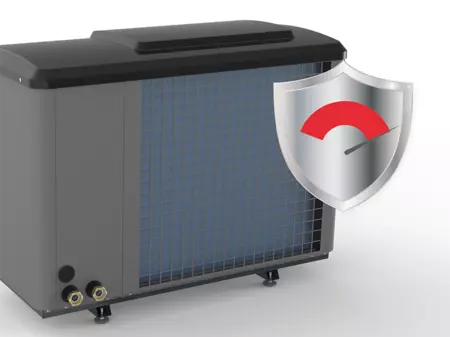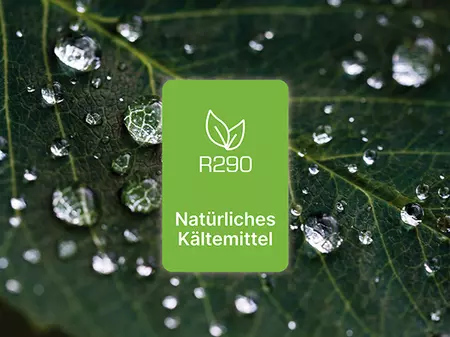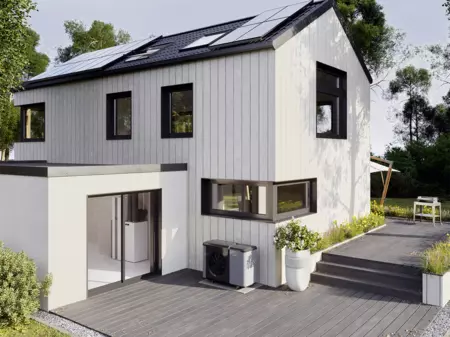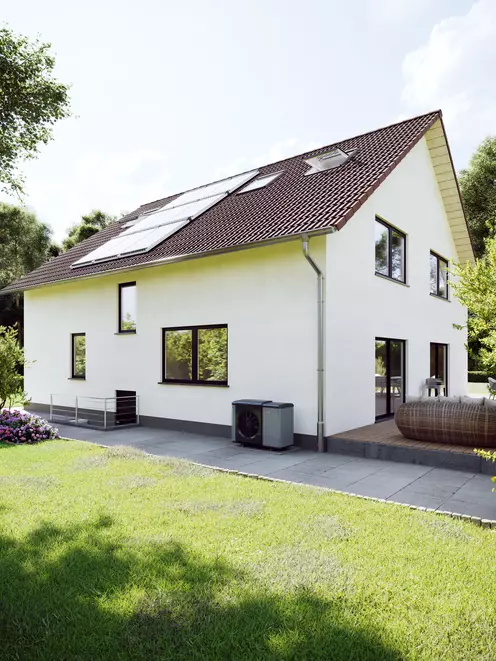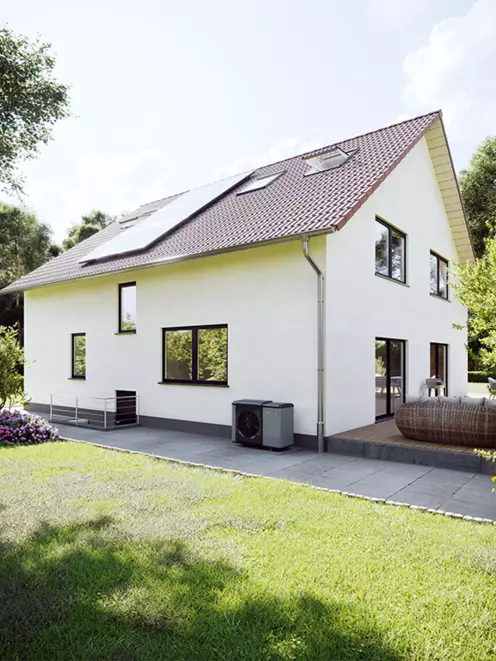The volume of the heat pump depends on the heat source and the design. With modern heat pumps like the WOLF CHA Monoblock, the noise level is less than that of rain. It is best to compare the noise level of a heat pump at various operating points according to the manufacturer’s data before making a purchase.
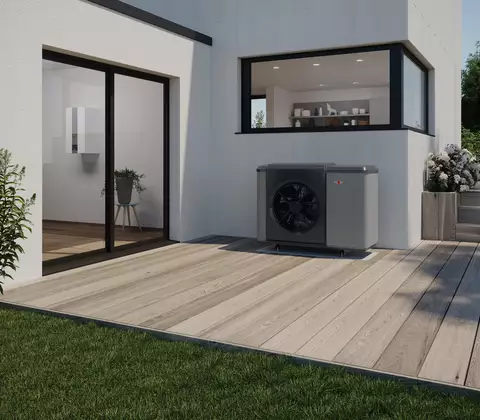
Understanding heat pumps
Efficient and climate-friendly heating
Heat pumps are the most modern of all types of heating. They offer an efficient and environmentally friendly means of heating that essentially makes you independent of fossil fuels. Learn all about heat pumps in our comprehensive guide.
Heat pumps are increasingly popular
Did you know that heat pumps are the most popular form of heating in new buildings? This environmentally friendly heating technology is even more commonly installed in new buildings than classic gas heating. But these heat generators are still worth consideration in older homes as well. The sales figures grew by 40% in 2020 compared with the previous year.
They owe their popularity to their high efficiency, low operating costs and climate-friendly operating principle. After all, a heat pump simply uses freely available energy from the air, ground or groundwater. If you combine a heat pump with your own photovoltaic system, you can even heat in an entirely climate-neutral manner.
The functioning principle of a heat pump is based on the use of freely available environmental energy. Various heat sources can be utilised for this. The different heat pump types are named according to the respective heat source:
- Ambient air: Air-to-water heat pump
- Ground: Brine-to-water heat pump (also called a geothermal heat pump)
- Groundwater: Water-to-water heat pump
Regardless of the environmental source, the heat pump always uses the same cyclical process to make the environmental heat available to the heating system. This cycle consists of four steps.
1. Evaporation
The ambient heat is used in the evaporator to evaporate the liquid refrigerant in the heat pump, putting it into a gaseous state.
2. Compression
The gaseous refrigerant is compressed by the electrically powered compressor. This compression increases the refrigerant temperature to the desired level. Some electricity is required for this step.
3. Condensation
The refrigerant then transfers its heat to the heating system of the building, cooling and condensing in the process, returning it to a liquid state.
4. Expansion
The expansion valve lowers the pressure of the refrigerant again, cooling it further. It then flows back into the evaporator, and the cycle begins again.
Air-to-water heat pump
Air is available everywhere and is easy to use as a heat source. This has made air-to-water heat pumps the most popular type. Roughly 70% of all installed heat pumps use the ambient air as a heat source.
Air-to-water heat pumps also feature a relatively uncomplicated technical design and keep purchase and maintenance costs impressively low. However, their efficiency is somewhat lower than that of heat pumps that utilise other heat sources.
Water-to-water heat pump
Groundwater has a relatively constant, high temperature year-round. This makes operation of the heat pump particularly efficient, meaning correspondingly low energy costs.
They are more complicated to install than an air-to-water heat pump, however, since a well must generally be bored to tap into groundwater as a heat source. Environmental regulations must also be taken into account.
Brine-to-water heat pump
To make use of geothermal heat, you can lay horizontal collectors or install a vertical geothermal well.
With horizontal collectors, it is important to have sufficient open space available. Geothermal wells require less space but can extend as far as 100 meters into the ground. The collectors and wells of brine-to-water heat pumps are generally made of plastic and filled with brine – water mixed with an antifreeze agent.
This type of heat pump offers an impressively constant temperature level thanks to its high efficiency, but installation is relatively expensive and involved.
The efficiency advantages of heat pumps are most clearly realised in a new build. This is because a modern building generally makes use of panel heating that requires only a very low temperature level. One example is underfloor heating, which transfers heat to the room air over a large surface area. In principle, the lower the flow temperature in the heating system, the more efficient the heat pump operation.
However, you can also effectively install a heat pump in an existing building. Hybrid systems are of particular interest here, such as a heat pump paired with a conventional heating appliance for peak loads. This combines the environmental friendliness of the heat pump with the high output of classic heating methods.
If low flow temperatures are possible, a heat pump can also be used as a sole heat generator in an existing building. This may require some alterations to the building, such as better insulation or new floor heating. Both are eligible for subsidies and will pay for themselves in only a short time.
When deciding on which type of heat pump to install, you should also consider the physical situation. For instance, installing horizontal geothermal collectors on an already developed property can require considerable construction measures. The simplest option is to install an air-to-water heat pump.
WOLF heat pumps are able to convert surplus electricity into thermal energy regardless of the current daily demand. This can be done directly, for example by the heat generator heating directly in the transition months or using the surplus energy in the summer months to use it directly for mild cooling.
In addition, the surplus energy can be stored temporarily, for example in a hot water or buffer storage tank, in order to fall back on it at a later time.
What does SG Ready mean?
"SG Ready" is a seal or certificate created by the German Heat Pump Association and 17 manufacturers that identifies smart grid-capable heat pumps as such. This means that a WOLF heat pump can communicate with so-called "smart grids".
Advantages
- Use surplus electricity for heating, hot water and mild cooling in summer
- Increases sensible self-consumption of PV electricity
- Grid relief and stabilisation, ecological added value
- Running operating costs
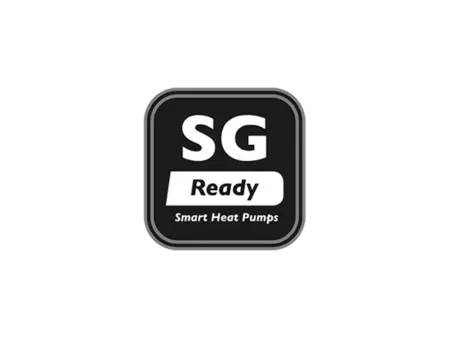
07. Where to install a heat pump
A heat pump can be installed either indoors or outdoors. With a split unit, you have the option of combining both installation types. Read on to learn about the pros and cons of each type:
Outdoor installation
With an outdoor installation, the heat pump is situated outside of the building. The heated water is pumped into the building in heating pipes, meaning that only small holes in the outer wall are required. Inside the home, you only need to install a small amount of system equipment, but this takes up less space than a fully indoor setup.
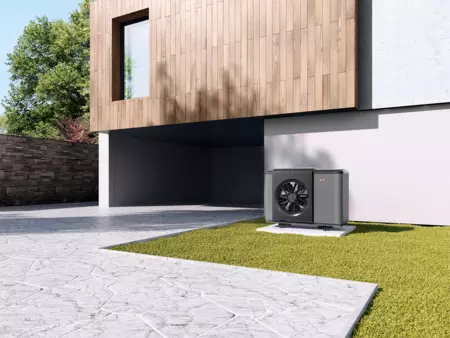
Split system with outdoor unit
Split units consist of an outdoor and an indoor unit. With this type of installation, the evaporator and compressor are installed outdoors and connected to the indoor unit by a refrigerant line.
Indoor installation
Indoor installation is an option if sufficient space is available. In this case, the outside air is brought into the building via ducts. The units generally take up about one square meter of floor space and are two meters tall. With an indoor installation, you should take into account the noise produced at the ventilation grills, but this generally remains at a reasonable level. The advantage of this type of installation is that you can keep your outdoor space free of any heating equipment.

08. Tips for saving even more energy
With these simple, practical tips, you can save even more heating energy on a daily basis and reduce the energy costs of your heat pump even further:
Lower the electricity costs of your heat pump by supplying the device with photovoltaic power that you generate yourself or by searching out a low electricity rate.
Take note of the flow temperature in the heating system. The lower the flow temperature is set, the more efficiently the heat pump operates.
If space permits, take advantage of the nearly constant temperature of the ground or groundwater. Water-to-water heat pumps and brine-to-water heat pumps operate somewhat more efficiently than air-to-water heat pumps.
Use panel heating to enable efficient heat transfer at a low temperature level.
Answering your questions about heat pumps
Generally, it is sufficient to have a heat pump inspected by a specialist once a year. Heat pumps are nearly maintenance-free, so their maintenance costs are very low.
There are synthetic and natural refrigerants for heat pumps. Synthetic refrigerants generally have a high greenhouse gas potential and are therefore harmful to the climate. Modern refrigerants like propane (R290), on the other hand, have a very low greenhouse gas potential.
There are various ways to harmonise a heat pump with the look of the outdoor area around it. However, it is important for the air intake and discharge sides of the heat pump to be freely accessible.

Our recommendation: The CHA Monoblock
50 years of experience have gone into the development and design of our top seller in the heat pump sector.
